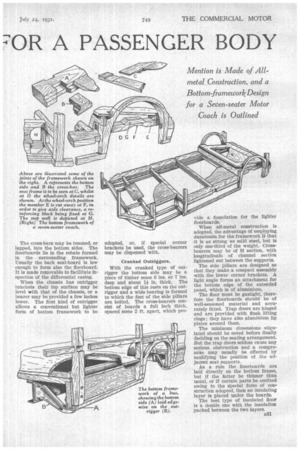MAKING A FOUNDATION OR A PASSENGER BODY
Page 48

Page 49

If you've noticed an error in this article please click here to report it so we can fix it.
This Week Our Bodybuilding Expert Deals with the Construction of the Bottom Framework of the Coach and Bus
WHEN a chassis has no outrigger mounting brackets, the cross-bearers are the most important part of the bottom framework, because they support the overhang of the body on each side. In order that full advantage may be taken of the low-loading line the cross-bearers are flitch plated, so that their thickness may be reduced to a minimum.
Usually there are four main longitudinal members of the bottom framework. The two outer ones are lapped to the ends of the crossbearers and are checked out for the joints with the side pillars.
The Bottom Side.
The bottom side, which is interrupted at the span of the wheelarch, may be a comparatively light rail. If it projects above the crossbearers for an amount equal to the thickness of the floorboards, the last-named may lie on the crossbearers and be flush with the bottom sides.
The two inner longitudinals are lapped flush with the cross-bearers, but in order that the latter may not be unduly weakened the lap joint is made by cutting the longitudinal deeper than the cross-bearer.
The subsidiary members of the bottom framework include the bars P.30 at the back of the wheel-arch, those which form a bearing for the trap doors and the battens required to form part of a step well. These features are all clearly illustrated in the accompanying drawings of the various details.
The cross-bar at the back is wide enough to be shaped for the rounded rear corners. It is mortised for the tenons of the inner longitudinals, and brackets or gusset plates are bolted at the corners as a reinforcement. With a small coach, such as a seven-seater, the bottom framework is similar to that of a private car. In this instance the bottom sides, rather than the cross-bearers, are all-important, because the former rest directly on the chassis.
When measured overall, the two bottom sides bolted to the chassis must be as wide as the body is at this level. For this reason they are often 10 ins. wide. A little weight may be saved by hollowing them out on the under side. The cross-bars may be tenoned, or lapped, into the bottom sides. The floorboards lie in the rebate formed in the surrounding framework. Usually the back seat-board is low enough to form also the floorboard. It is made removable to facilitate inspection of the differential casing.
When the chassis has outrigger brackets their top surface may be level with that of the chassis, or a bearer may be provided a few inches lower. The first kind of outrigger allows a conventional but lighter form of bottom framework to be adopted, or, if special corner brackets be used, the cross-bearers may be dispensed with.
Cranked Outriggers.
With the cranked type of outrigger the bottom side may be a piece of timber some 6 ins. or 7 ins. deep and about n in. thick. The bottom edge of this rests on the outrigger and a wide bearing is formed to which the feet of the side pillars are bolted. The cross-bearers consist of boards a full inch thick, spaced some 2 ft. apart, which pro
vide a foundation for the lighter floorboards.
When all-metal construction is adopted, the advantage of employing duralumin for the framework is that it is as strong as mild steel, but is only one-third of the weight. Crossbearers may be of H section, with longitudinals of channel section lightened out between the supports.
The side pillars are designed so that they make a compact assembly with the lower corner brackets. A light angle forms an attachment for the bottom edge of the extended panel, which is of aluminium.
The floor must be gastight, therefore the floorboards should be of well-seasoned material and accurately fitted. Trap doors are hinged and are provided with flush lifting rings ; they have also aluminium lip plates around them.
The minimum dimensions stipulated should be noted before finally deciding on the seating arrangement. But the trap doors seldom cause any serious obstruction and a compromise may usually be effected by modifying the position of the adjacent seat supports.
As a rule the floorboards are laid directly on the bottom frame, but if the hitter be thinner than usual, or if certain parts be omitted owing to the special form of construction adopted, then an insulating layer is placed under the boards.
The best type of insulated floor is a double one with the insulation packed between the two layers.




































































































